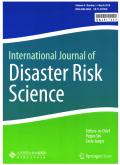地震-泥石流灾害链中建筑物物理脆弱性评估
IF 4
2区 地球科学
Q2 GEOSCIENCES, MULTIDISCIPLINARY
引用次数: 0
摘要
大地震不仅对建筑物造成直接破坏,还会引发泥石流对建筑物造成二次破坏,形成更具破坏性的地震-泥石流灾害链。对建筑物脆弱性进行定量评估对于灾后的损害评估和灾前预防至关重要。采用基于推覆的力学分析方法,建立了地震-泥石流灾害链中建筑物物理易损性评价模型,对北川县建筑物进行易损性评价。根据地震-泥石流灾害链中具体的事件顺序,建筑物的地震易损性为79%,受损建筑物对泥石流的流动冲击易损性为92%,掩埋易损性为28%,灾害链下建筑物的整体易损性为57%。通过对不同易损性评估方法的比较,我们发现灾害链过程下建筑物的物理易损性不等于对独立灾害易损性的统计总和,这意味着在灾害链过程中建筑物的结构特性和易损性发生了变化。我们的研究结果为理解地震-泥石流灾害链中的建筑脆弱性以及其他灾害链下的建筑脆弱性提供了一个综合的解释。本文章由计算机程序翻译,如有差异,请以英文原文为准。
Assessment of Building Physical Vulnerability in Earthquake-Debris Flow Disaster Chain
Abstract Large earthquakes not only directly damage buildings but also trigger debris flows, which cause secondary damage to buildings, forming a more destructive earthquake-debris flow disaster chain. A quantitative assessment of building vulnerability is essential for damage assessment after a disaster and for pre-disaster prevention. Using mechanical analysis based on pushover, a physical vulnerability assessment model of buildings in the earthquake-debris flow disaster chain is proposed to assess the vulnerability of buildings in Beichuan County, China. Based on the specific sequence of events in the earthquake-debris flow disaster chain, the seismic vulnerability of buildings is 79%, the flow impact and burial vulnerabilities of damaged buildings to debris flow are 92% and 28% respectively, and the holistic vulnerability of buildings under the disaster chain is 57%. By comparing different vulnerability assessment methods, we observed that the physical vulnerability of buildings under the disaster chain process is not equal to the statistical summation of the vulnerabilities to independent hazards, which implies that the structural properties and vulnerability of buildings have changed during the disaster chain process. Our results provide an integrated explanation of building vulnerability, which is essential for understanding building vulnerability in earthquake-debris flow disaster chain and building vulnerability under other disaster chains.
求助全文
通过发布文献求助,成功后即可免费获取论文全文。
去求助
来源期刊

International Journal of Disaster Risk Science
GEOSCIENCES, MULTIDISCIPLINARYMETEOROLOGY-METEOROLOGY & ATMOSPHERIC SCIENCES
CiteScore
6.50
自引率
7.50%
发文量
63
审稿时长
13 weeks
期刊介绍:
The International Journal of Disaster Risk Science (IJDRS) provides a pioneering platform for researchers and practitioners aiming at greater resilience and integrated risk governance in view of local, regional, and global disasters. IJDRS breaks new ground in research about disaster risks by connecting in-depth studies of actual disasters and of specific practices of disaster risk management with investigations of the global dynamics of disaster risks and theories and models relevant for advanced integrated risk governance.
 求助内容:
求助内容: 应助结果提醒方式:
应助结果提醒方式:


